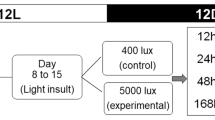Abstract
• Background: Blue-light exposure inhibits cytochrome oxidase and may therefore inhibit retinal metabolism. The reduced metabolism decreases the extrusion of calcium from the photoreceptor cell. Overload of calcium is proposed as one of the factors that lead to photoreceptor degeneration after light exposure. The light-induced photoreceptor degeneration can be ameliorated by calcium overload blocker. In the present study the calcium concentration was measured in the inner and outer segment layer of the rat retina. • Methods: Six eyes were exposed to blue (404 nm) light at a retinal dose of 380 kJ/m2. Five eyes served as the control group. The calcium and sulphur distributions were measured with a nuclear microprobe in the freeze-dried rat retina. The proton beam size was 12 × 12 μm and the energy of the protons was 2.55 MeV The calcium concentration was calculated using sulphur as a reference. • Results: The level of calcium per milligram sulphur was 21 μg (range 17–23 μg) in the inner segment of the control retina. It increased to 62 μg/mg sulphur (range 52–67 μg) and 61 μg/mg sulphur (range 58–66 μg) 1 h and 12 h after blue-light exposure, respectively. • Conclusion: The findings of the present study support the idea that accumulation of calcium in the inner segment layer is one of the factors that cause photoreceptor degeneration.
Similar content being viewed by others
References
Akpalaba CO, Oraedu ACI, Nwanze EAC (1986) Biochemical studies on the effects of continuous light on the albino rat retina. Exp Eye Res 42:1–9
Chen E (1993) Inhibition of cytochrome oxidase and blue-light damage in rat retina. Graefe's Arch Clin Exp Ophthalmol 231:416–423
Chen E, Söderberg P, Lindström B (1992) Cytochrome oxidase activity in rat retina after exposure to 404 nm blue light. Curr Eye Res 11:825–831
Edward DP, Lam TT, Shahinfar S, Li J, Tso MOM (1991) Amelioration of light induced retinal degeneration by a calcium overload blocker. Arch Ophthalmol 109:554–562
Forslind B, Malmqvist KG, Pallon J (1991) Proton induced X-ray emission analysis of biological specimens — past and future. Scanning Microsc 5:877–884
Ham WT Jr, Mueller HA, Sliney DH (1976) Retinal sensitivity to damage from short wavelength light. Nature 260:153–155
Hansson HA (1970) A histochemical study of oxidative enzymes in rat retina damaged by visible light. Exp Eye Res 9:285–296
Johansson GI, Pallon J, Malmqvist KG, Akselsson KP (1981) Calibration and long-term stability of a PIXE setup. Nucl Instrum Methods 181:81–88
Johansson SAE, Campbell JL (1988) PIXE — a novel technique for elemental analysis. Wiley, New York
Kagan VE, Shvedova AA, Novikov KN, Yu P (1973) Light induced free radical oxidation of membrane lipids in photoreceptors of frog retina. Biochem Biophys Acta 330:76–79
Lindh U (1993) Proceedings, 3rd International Conference on Nuclear Microprobe Technology and Applications. Nucl Instrum Methods B77
Noell WK, Walker VS, Kang BS, Berman S (1966) Retinal damage by light in rats. Invest Ophthalmol 5:450–473
Pautler EL, Morita M, Beezley D (1990) Hemoprotein(s) mediate blue light damage in the retinal pigment epithelium. Photochem Photobiol 51:599–605
Penn JS, Anderson RE (1991) Effects of light history on the rat retina. In: Osborne N, Chader GJ (eds) Progress in retinal research. Pergamon Press, Oxford, p 75–98
Penn JS, Howard AG, William TP (1985) Light damage as a function of “light history” in the albino rat. In: La Vail MM, Hollyfield JG, Anderson RE (eds) Retinal degeneration: experimental and clinical studies. Liss, New York, pp 439–447
Rapp LM, Tolman BL, Dhindsa HS (1990) Separate mechanisms for retinal damage by ultraviolet-A and mid-visible light. Invest Ophthalmol Vis Sci 31:1186–1190
Steinberg RH (1987) Monitoring communications between photoreceptors and pigment epithelial cells: effects of “mild” systemic hypoxia. Invest Ophthalmol Vis Sci 28:1888–1904
Wiegand RD, Joel CD, Rapp LM, Nielsen JC, Maude MB, Anderson RE (1986) Polyunsaturated fatty acids and vitamin E in rat rod outer segments during light damage. Invest Ophthalmol Vis Sci 27:727–733
Winkler BS, Noell WK, Smith JC (1984) A rhodopsin mediated light damage in the isolated retina is calcium dependent. Invest Ophthalmol Vis Sci 25 [Suppl]: 57
Wonnacott TH, Wonnacott RJ (1990) Nonparametric and robust statistics. In: Wonnacott TH, Wonnacott RJ (eds) Introductory statistics. Wiley, New York, pp 517–548
Yau KW, Nakatani K (1985) Light-induced reduction of cytoplasmic free calcium in retinal rod outer segment. Nature 313:579–582
Author information
Authors and Affiliations
Rights and permissions
About this article
Cite this article
Chen, E., Pallon, J. & Forslind, B. Distribution of calcium and sulphur in the blue-light-exposed rat retina. Graefe's Arch Clin Exp Ophthalmol 233, 163–167 (1995). https://doi.org/10.1007/BF00166609
Received:
Revised:
Accepted:
Issue Date:
DOI: https://doi.org/10.1007/BF00166609




